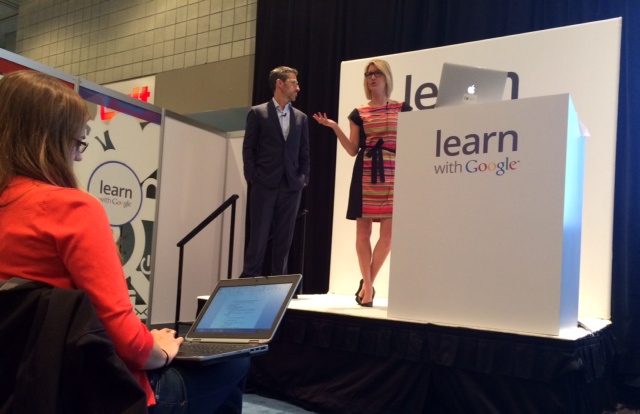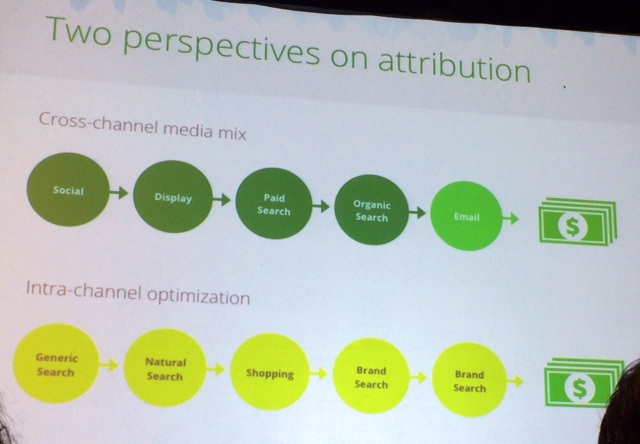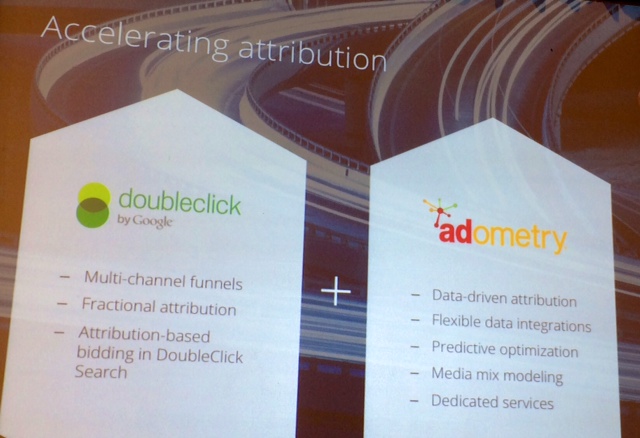SMX East Liveblog: Learn With Google — Attribution Strategies
In the Learn with Google classroom, the first topic of the morning is: Attribution Strategies to Inform Your Search and Digital Investments.
“Why is attribution essential? Because understanding the interplay of channels leads to smarter marketing investments.”

Speakers:
- Rachel Klooz, Sr. Account Manager, Google DoubleClick Search
- Justin Huskamp, Product Marketing Manager, DoubleClick Search
Let’s Make Advertising Better Online
- With moments that matter
- Enable better decisions >> this presentation
- Constantly innovate
Agenda:
- Getting on the same page about attribution
- Getting started with modeling in DoubleClick (not strategies just for DoubleClick, can also work for Google Analytics — rules-based models that can work in any platform)
- Advanced modeling
- Case study
- Drawing actionable insights
- What’s the deal with Adometry
Getting on the same page
What is multi-channel attribution? It’s the intuitive understanding that the $100 sale of the red shoes you just bought was immediately preceded by an email, which was probably preceded with a whole lot of other contacts and clicks.
Why is attribution essential? Because understanding the interplay of channels leads to smarter marketing investments.
Makes sense! Where’s my attribution model? There is no perfect model. Only better ones. They depend on your business, its strategy and customers. Even in the same vertical, we’ve seen the same attribution model work in remarkably different ways. It’s important that companies own their marketing decisions.

Getting started
Using basic attribution models and custom weighting, there are several models.
Standard Models:
- Last click or impression: all value assigned to the last click
- First click or impression: all value assigned to the first interaction (good for understanding the value of display advertising in reaching new people)
- Linear: all value assigned evenly across clicks (used as a basis for advanced modeling done further down the line)
- Time decay: value assigned by how close in time click was to conversion (recognizes that every interaction in the path has some value and that older interactions probably aren’t worth as much)
- Position-based: value earlier and later interactions more heavily (the stuff in the middle has value, but probably not as much as the first thing someone saw and the last stuff that got the conversion)
Now for the more advanced stuff
You could customize your own model. You need to know your cookie model. You need to know many interactions before conversion. You need a good scope of your business model; they should know the performance of what they’re doing today.
- Create granular modeling rules based on interaction type, position and time
- Instantly see the impact of changes
- Save and manage custom models
Example weighting: Impressions vs. Clicks
Example weighting: Brand vs. Generic
Brand terms do some work, but generic, non-branded terms are working harder for you.
Another example of where weighting comes into play with attribution is organic, and you may devalue that in your weighted attribution model as it’s not something you’re paying for.
Level 201, 301: custom model builder uses additional levers like time decay.
Level 401, 501 (advanced, where Google is looking at attribution for 2015): Augment your attribution practice with data-driven attribution, such as predictive modeling and predictive analysis. Things to be cautious of with this are correct setup and not letting the algorithm run without analysis.
Case study: Large independent agency
Needed help with display, email, affiliate, retargeting — they had a lot of types of media and were confused.
Approach:
- Identify conversion points of interest
- Assign revenue values to leads
- Create custom dimensions based on media buckets of interest
- Incorporate alternative impression weighting and time decay into custom models
- Combine media cost data to produce ROAS analysis
The recommendation based on this ROAS analysis was that some of the search budget and teams could be reallocated to display. Search was getting all the credit because it was the last click.
Drawing actionable insights
- First easy thing is to compare first click and last click and figure out your converters, your closers, your lead generators.
- Filter to remarketing assists to uncover value hidden by last-click model, but note that this is correlation and not causation. To really know the role of remarketing, do an A/B test where half of your traffic sees remarketing and the other half doesn’t.
Things you can do today:
- Experiment with standard models in the tool of your choice. Look at how ROAS/ROI changes as you go through different models.
- Compare models to gain insight into acquirers vs. closers.
- Create granular rules based on interaction type, position and time. To do this, look at your path links. What’s the usual period of time it takes for someone to consider and purchase. Note that cookie windows longer than 2 months raise issues like loss and drop off.
- Test by altering cookie windows and compare data.
So what’s the deal with Adometry?
Google acquired Adometry in late spring. DoubleClick and Google Analytics do “online” really well. Adometry adds a marriage of online and offline. Today’s tools have limits. They don’t generally go across devices that well, and they don’t generally go by clicks. Adometry tries to measure the effects of TV and at home. Adometry is intended to create a closed feedback loop.
Q&A
Q: I use Google Analytics for multi-channel attribution. Some of the things that you showed here, how does that translate? You’ve got multi-channel attribution here and it looks a lot like GA. What’s different?
A: It’s built on the same backend and infrastructure. A lot of the models and examples you could do in GA. You can alter cookie windows in GA.
Q: How does Universal Analytics track between devices?
A: Universal uses signed-in users in an anonymized way. Users signed in to Chrome across devices that represents some sample of the population.
Q: I have frustration over reporting the time period between an impression and the last click.
A: That’s an interesting use case. Let’s follow up.

LEAVE A REPLY















